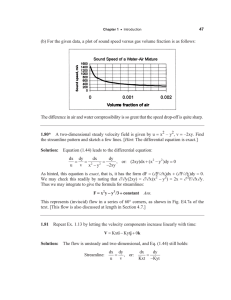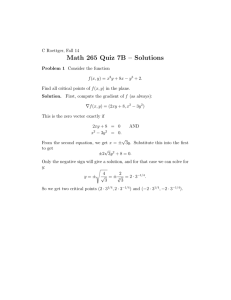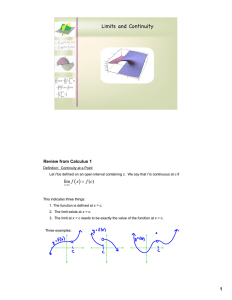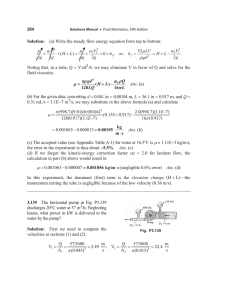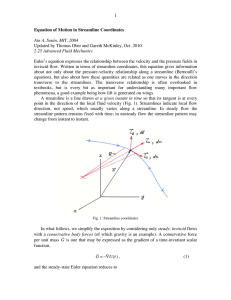³ W G w
advertisement
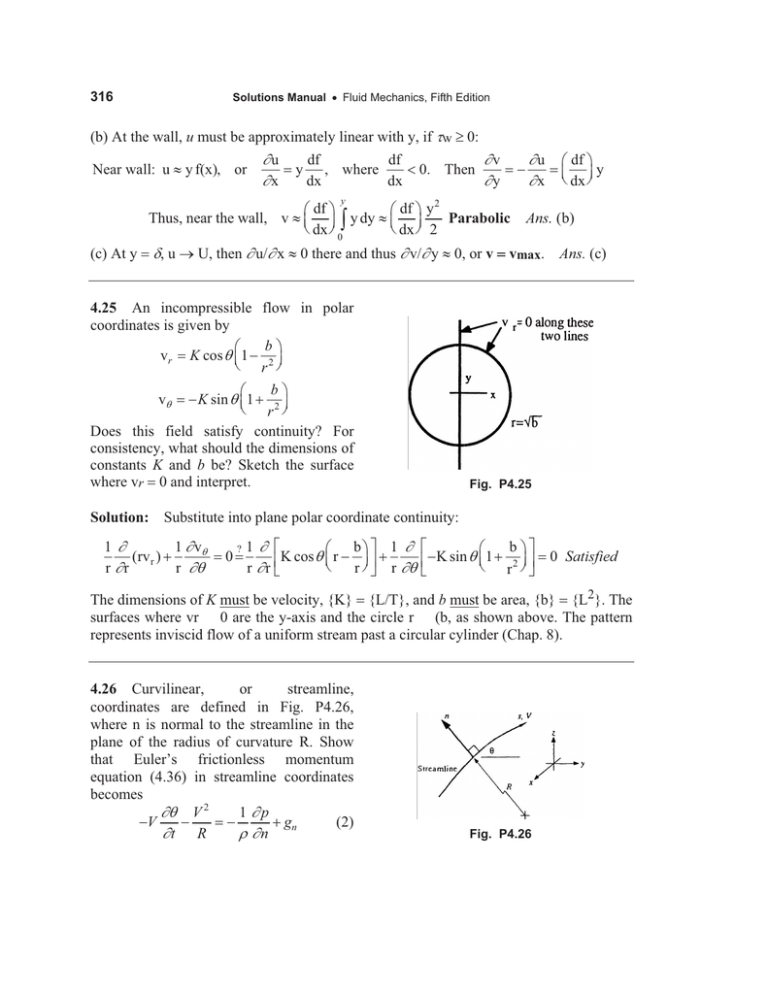
316
Solutions Manual x Fluid Mechanics, Fifth Edition
(b) At the wall, u must be approximately linear with y, if Ww t 0:
wu
df
df
wv
Near wall: u | y f(x), or
y , where
0. Then
wx
dx
dx
wy
wu
wx
§ df ·
¨© ¸¹ y
dx
y
2
§ df ·
§ df · y
Thus, near the wall, v | ¨ ¸ ³ y dy | ¨ ¸
Parabolic
© dx ¹ 0
© dx ¹ 2
(c) At y
Ans. (b)
G, u o U, then wu/wx | 0 there and thus wv/wy | 0, or v vmax. Ans. (c)
4.25 An incompressible flow in polar
coordinates is given by
b·
§
vr K cos T ¨ 1 2 ¸
© r ¹
b·
§
K sin T ¨ 1 2 ¸
© r ¹
Does this field satisfy continuity? For
consistency, what should the dimensions of
constants K and b be? Sketch the surface
where vr 0 and interpret.
vT
Fig. P4.25
Solution: Substitute into plane polar coordinate continuity:
1w
1 w vT
(rv r ) r wr
r wT
0
"
1w ª
§ b· º 1 w
K cos T ¨ r ¸ » «
©
r wr ¬
r ¹ ¼ r wT
b ·º
ª
§
« K sin T ¨© 1 r 2 ¸¹ »
¬
¼
0 Satisfied
The dimensions of K must be velocity, {K} {L/T}, and b must be area, {b} {L2}. The
surfaces where vr 0 are the y-axis and the circle r (b, as shown above. The pattern
represents inviscid flow of a uniform stream past a circular cylinder (Chap. 8).
4.26 Curvilinear,
or
streamline,
coordinates are defined in Fig. P4.26,
where n is normal to the streamline in the
plane of the radius of curvature R. Show
that Euler’s frictionless momentum
equation (4.36) in streamline coordinates
becomes
wT V 2
1 wp
V
g
(2)
wt R
U wn n
Fig. P4.26
317
Chapter 4 x Differential Relations for a Fluid Particle
Further show that the integral of Eq. (1) with respect to s is none other than our old friend
Bernoulli’s equation (3.76).
Solution: This is a laborious derivation, really, the problem is only meant to
acquaint the student with streamline coordinates. The second part is not too hard,
though. Multiply the streamwise momentum equation by ds and integrate:
wV
dp
dp
dp
ds V dV gs ds U g sin T ds U g dz
U2
wt
2
2
V 22 V12
dp
wV
Integrate from 1 to 2: ³
ds ³
U g z 2 z1 0 (Bernoulli) Ans.
w
t
2
1
1
4.27 A frictionless, incompressible steady-flow field is given by
V
2xyi – y2j
in arbitrary units. Let the density be U0 constant and neglect gravity. Find an expression
for the pressure gradient in the x direction.
Solution: For this (gravity-free) velocity, the momentum equation is
§ wV
wV·
v
© wx
w y ¸¹
U¨u
Solve for p
p, or: Uo [(2xy)(2yi) ( y 2 )(2xi 2yj)] p
Uo (2xy 2 i 2y 3 j), or:
wp
wx
Uo 2xy 2
Ans.
4.28 If z is “up,” what are the conditions on constants a and b for which the velocity
field u ay, X bx, w 0 is an exact solution to the continuity and Navier-Stokes
equations for incompressible flow?
Solution: First examine the continuity equation:
wu wv ww
wx wy wz
Given gx
gy
?
0 and w
0
w
w
w
(ay) (bx) (0) 0 0 0 for all a and b
wx
wy
wz
0, we need only examine x- and y-momentum:
§ w 2u w 2u ·
§ wu
wu·
wp
v
P
¨ 2 2¸
w y ¸¹
wx
© wx
©wx wy ¹
U ¨u
§ wv
wv·
v
w y ¸¹
© wx
U ¨u
U[(ay)(0) (bx)(a)] wp
P (0 0)
wx
§ w 2v w 2v ·
wp
wp
P ¨ 2 2 ¸ U[(ay)(b) (bx)(0)] P (0 0)
wy
w
y
w
x
w
y
©
¹
![The streamlines are logarithmic spirals moving out from the origin. ... about O.] This simple distribution is often used to...](http://s2.studylib.net/store/data/012446347_1-856dfe1450220540b95d56f386c12aa6-300x300.png)
